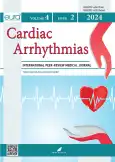Аритмический вариант манифестации паранеопластического эндомиокардита Леффлера. Клинический случай
- Авторы: Гришкин Ю.Н.1, Зимина В.Ю.1, Бабаян А.А.2, Карчикьян П.О.2, Бутаев Т.Д.1, Григорьева О.В.2
-
Учреждения:
- Северо-Западный государственный медицинский университет им. И.И. Мечникова
- Городская Покровская больница
- Выпуск: Том 4, № 2 (2024)
- Страницы: 29-40
- Раздел: Клинические случаи
- URL: https://journal-vniispk.ru/cardar/article/view/269903
- DOI: https://doi.org/10.17816/cardar635455
- ID: 269903
Цитировать
Аннотация
Представлен клинический случай хронического волнообразного течения парнеопластического эндомиокардита Леффлера, ведущими проявлениями которого стали желудочковые нарушения ритма. В работе демонстрируется сложность ранней диагностики редкой патологии у полиморбидного пациента и предпринимается попытка определить «ключи» к верной диагностической и лечебной тактике ведения подобных пациентов.
Полный текст
Открыть статью на сайте журналаОб авторах
Юрий Николаевич Гришкин
Северо-Западный государственный медицинский университет им. И.И. Мечникова
Email: yurigrishkin@yandex.ru
SPIN-код: 9997-2073
д-р мед. наук, профессор
Россия, Санкт-ПетербургВера Юрьевна Зимина
Северо-Западный государственный медицинский университет им. И.И. Мечникова
Email: Vera.Zimina@szgmu.ru
ORCID iD: 0000-0002-5655-8981
SPIN-код: 7202-1071
канд. мед. наук
Россия, Санкт-ПетербургАнаит Альбертовна Бабаян
Городская Покровская больница
Автор, ответственный за переписку.
Email: babayan.anahit24@gmail.com
ORCID iD: 0009-0001-0898-2622
врач-кардиолог
Россия, Санкт-ПетербургПавел Олегович Карчикьян
Городская Покровская больница
Email: p1472141@mail.ru
ORCID iD: 0000-0001-8288-0352
SPIN-код: 3138-0839
канд. мед. наук
Россия, Санкт-ПетербургТамерлан Дзамболатович Бутаев
Северо-Западный государственный медицинский университет им. И.И. Мечникова
Email: butayevtd@yandex.ru
ORCID iD: 0009-0005-8314-808X
канд. мед. наук
Россия, Санкт-ПетербургОксана Валерьевна Григорьева
Городская Покровская больница
Email: ovg-spb-6868@mail.ru
врач-патологоанатом
Россия, Санкт-ПетербургСписок литературы
- Hoffman R., Edward J., Benz E., et al. Hematology, basic principles and practice. 8th edition. Elsevier, 2022. P. 1243–1257. doi: 9780323733892
- Löffler W. Wissenschaftliche Rosinen aus 125 Jahren SMW. Der II. Internationalen Medizinischen Woche in der Schweiz gewidmet. Luzern, 31. August-5. September 1936. Endocarditis parietalis fibroplastica mit Bluteosinophilie. Ein eigenartiges Krankheitsbild. 1936 // Schweizerische Medizinische Wochenschrift. 1995. Vol. 125. S. 1837–1840.
- Chao B.H., Cline-Parhamovich K., Grizzard J.D. Fatal Loeffler’s endocarditis due to hypereosinophilic syndrome // Am J Hematol. 2007. Vol. 82, N 10. P. 920–923. doi: 10.1002/ajh.20933
- Crane M.M., Chang C.M., Kobayashi M.G., Weller P.F. Incidence of myeloproliferative hypereosinophilic syndrome in the United States and an estimate of all hypereosinophilic syndrome incidence // J Allergy Clin Immunol. 2010. Vol. 126, N 1. P. 179–181. doi: 10.1016/j.jaci.2010.03.035
- Mubarik A., Iqbal A.M. Loeffler Endocarditis. [Updated 2024 Jan 7]. В кн.: StatPearls [Internet]. Treasure Island (FL): StatPearls Publishing, 2024 Jan. Режим доступа: https://www.statpearls.com/point-of-care/21092 Дата обращения: 18.09.2024.
- Ogbogu P.U., Rosing D.R., Horne M.K. 3rd. Cardiovascular manifestations of hypereosinophilic syndromes // Immunol Allergy Clin North Am. 2007. Vol. 27, N 3. P. 457–475. doi: 10.1016/j.iac.2007.07.001
- Отто К.М. Клиническая эхокардиография: практическое руководство / пер. с англ.; под ред. М.М. Галагудзы, Т.М. Домницкой, М.М. Зеленикина, и др. Москва: Логосфера, 2019. C. 688–690. EDN: BUAHUQ
- Vereckei A., Duray G., Szénási G., et al. New algorithm using only lead aVR for differential diagnosis of wide QRS complex tachycardia // Heart Rhythm. 2008. Vol. 5, N 1. P. 89–98. doi: 10.1016/j.hrthm.2007.09.020
- 9. Lobo R., Jaffe A.S., Cahill C., et al. Significance of high-sensitivity troponin T after elective external direct current cardioversion for atrial fibrillation or atrial flutter // Am J Cardiol. 2018. Vol. 121, N 2. P. 188–192. doi: 10.1016/j.amjcard.2017.10.009
- Stevenson W.G., Friedman P.L., Sager P.T., et al. Exploring postinfarction reentrant ventricular tachycardia with entrainment mapping // J Am Coll Cardiol. 1997. Vol. 29. N 6. P.1180–1189. doi: 10.1016/s0735-1097(97)00065-x
- Туркина А.Г., Немченко И.С., Цыба Н.Н., и др. Клинические рекомендации по диагностике и лечению миелопролиферативных заболеваний, протекающих с эозинофилией. 2018. 30 c. EDN: RTBSCM
- Butt N.M., Lambert J., Ali S., et al. British committee for standards in haematology. Guideline for the investigation and management of eosinophilia // Br J Haematol. 2017. Vol. 176. N 4. P. 553–572. doi: 10.1111/bjh.14488
- Groh M., Rohmer J., Etienne N., et al. French guidelines for the etiological workup of eosinophilia and the management of hypereosinophilic syndromes // Orphanet J Rare Dis. 2023. Vol. 18, N. 1, P. 100. doi: 10.1186/s13023-023-02696-4
- Medscape [Электронный ресурс]. Samavedi V.A., Sacher R.A., Herrin V.E., et al. Hypereosinophilic syndrome clinical presentation. Режим доступа: https://emedicine.medscape.com/article/202030-clinical Дата обращения: 18.09.24.
Дополнительные файлы















